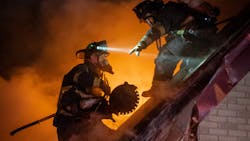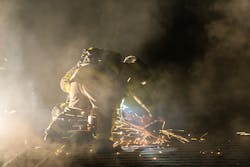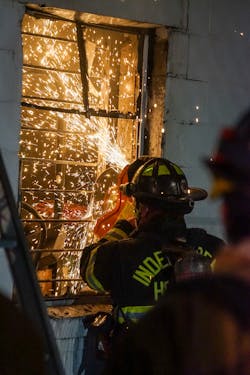Battery Technology in Saws: Changing the Future of Training
We have seen the evolution in ventilation fans from electric and gasoline-powered units to battery-powered models. We also have seen the change in extrication tool technology from large, bulky cutters, spreaders and rams that run off of vehicle batteries, to those that are tied to either a vehicle or portable pump, to models that run off of rechargeable batteries. The latter are lighter and more mobile than the alternate models.
Rotary saws and ventilation saws are the latest pieces of emergency services equipment to emerge out of the battery-powered evolution. These lighter-weight models are more versatile than their predecessors. Who would have imagined being able to cut with a ventilation saw in an immediately dangerous to life and health (IDLH) atmosphere?
New mentality
Battery-powered saws run the risk of being underutilized. A reason for this might be the understatement of their versatility of application in the IDLH and oxygen-deficient atmospheres that are faced in building fires and other hazardous situations—for vertical ventilation on a flat or pitched roof; for use vertically to enlarge openings or to cut rebar off of windows for RIT operations; for removal of debris around a chimney on a chimney fire; and for cutting concrete, other masonry products, shipping containers and other human-made products for technical rescue operations.DeWalt, Husqvarna, Makita and Milwaukee are among numerous vendors that have evolved their gasoline-powered saw offerings into battery-powered technology. A Husqvarna model even has built-in connectivity, which facilitates monitoring the saw’s location, runtime and service interval and receiving wireless updates. This up-to-the-minute data can be vital for maintenance and monitoring the efficiency of operations of the saw. (Similar technology, where use and location can be tracked, is found in the SCBA industry.)
With these evolutionary changes, an operational and functional fire service mindset must change, because many members are creatures of habit and only are comfortable with the idea of using the gasoline-powered saws that have worked for years.
Pluses and minuses
Lisa Dreher from Forbes Magazine, who is the author of “Three Keys to Doing Marketing Transparency Just Right,” believes that many consumers know that marketing techniques highlight the best qualities of a product or service. Unfortunately, many manufacturers and service providers downplay the less flattering aspects of what they sell. I share this because members might become enamored with what’s stated about battery-powered rotary saws and ventilation saws—even via what’s included in this article—but the limitations of these tools must be recognized.Recently, several individuals in my department’s technical rescue and FEMA Urban Search and Rescue Task Force teams used battery-powered rotary saws during a recent special operations training event. They were tasked with cutting rebar and concrete in old jail cells. They praised the saws for their capability to be used in confined spaces without the need for members to invest the time to ventilate the work areas. Of course, this is unlike what would have been required for the team members to handle the same tasks with gasoline-powered models, given their carbon monoxide emissions.
I have found that the lighter weight of the saws makes use over a long period less taxing physically. Also, because of the lighter weight and the decrease in the amount of torque compared with gasoline-powered counterparts, it’s easier and safer to cut with a battery-powered rotary saw in the horizontal position. This means that rooftop ventilation training might need to be reconsidered.
The way that I was taught and, thus, the way that I have been teaching is that the gasoline-powered rotary saw, when used for vertical ventilation, is used in the flat-roof setting. Reasons behind that include the depth of cut, the danger of pull-starting the saw on a pitched roof as well as the torque and power of the saw potentially causing stability issues for the users. With the inclusion of battery-powered operation, there could be a shift in the operational mindset, because there is no pull-starting, and the amount of torque and power isn’t as much of a safety issue or concern.
Putting saws in the hands of as many members as possible during as many training sessions as possible is extremely important. After all, repetition creates muscle memory, and when an actual incident dictates it, the saws will be used appropriately without any thought, just as is the case with donning gear, pulling lines and throwing ladders.On the flip side, my fellow department members experienced both significantly shorter battery life during heavy use than what’s listed by the manufacturer in the owner’s manual as well as significantly longer battery charging time than noted. Furthermore, they found that heavy continuous use caused low-amperage batteries to overheat (not be drained of power), which caused the saw to stop operating and required fresh batteries to be installed. Like it or not, you very well might need to consider transporting gasoline-powered models on your apparatus in addition to the battery-powered models. A backup option could be vital if you find that a battery-powered model isn’t doing what you need it to do.
Train, train, train
New equipment technology can bring with it new opportunities, and battery-powered operation of rotary saws and ventilation saws falls into this realm. That said, several consistencies exist between gasoline- and battery-powered models, the most significant being the necessity to train with them. Yes, starting the saw and bringing the blade or chain up to speed is great, but you must use it, and the time to find your particular pros and cons of these tools is in the training environment.
About the Author

Robert Faas Jr.
Robert Faas Jr. is a career captain with Montgomery County, MD, Fire & Rescue Service (MCFRS) who has 31 years of experience in the fire service. He is a member of Maryland Task Force 1 Urban Search and Rescue Team, a hazmat officer on the county Hazardous Incident Response Team, a member of the county Technical Rescue Team and an instructor at the Public Safety Training Academy. Faas serves as the vice president of F.O.O.L.S. International and is an instructor for On Scene Training Associates. He has served with fire companies in Charles Town, WV, the Schooley’s Mountain Fire Protection Association in Long Valley NJ, the Rindge, NH, Fire Department and the Sharpsburg, MD, Volunteer Fire Company. Faas was part of committees that were responsible for the development of the New Hampshire RIT program and the MCFRS RIT program and for the redevelopment of the Maryland Fire and Rescue Institute's Safety and Survival Program.



